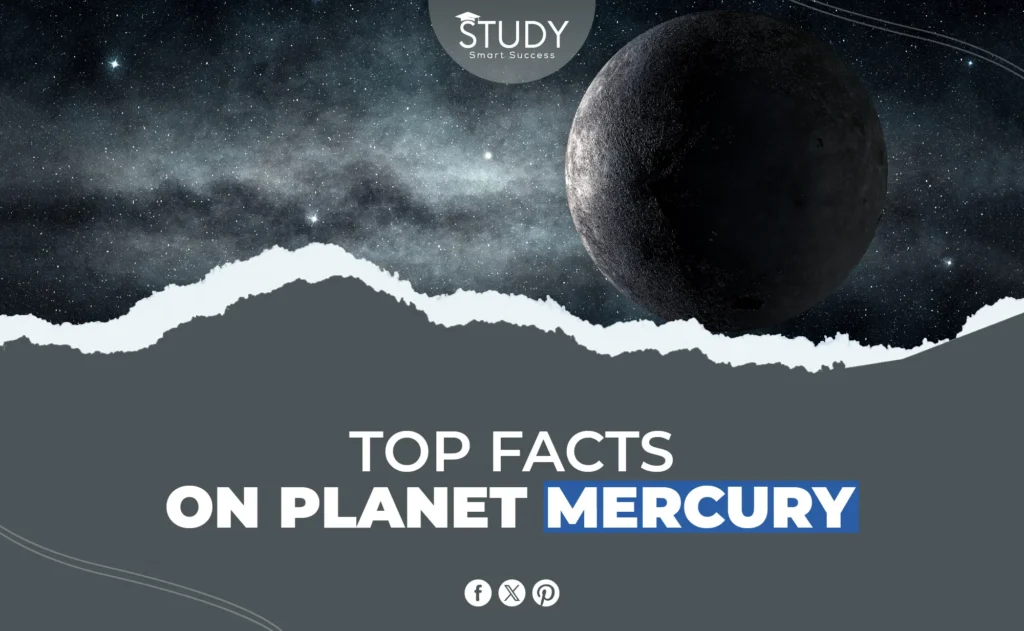Introduction
Mercury, named for the Roman deity messenger, is unique in our solar system. It’s the closest planet to the Sun and has a universe of extremes and mysteries that intrigue astronomers and space fans. We may see this little planet shortly before sunrise or after sunset, inviting us to explore its secrets and learn more about planetary formation and evolution. Find some amazing facts on the planet mercury in this article.
Mercury’s proximity to the Sun and environment make it a great research subject. Despite being overshadowed by Mars and Jupiter, Mercury provides important information on planetary dynamics near a star. Its severe temperatures, absence of atmosphere, and rich geological history help us understand the solar system.
Mercury is intriguing for its durability, orbital oddities, and surface conditions. How can a planet so near the Sun have geological features? Mercury may reveal Earth’s formation and maybe habitable planets surrounding other stars. Astronomers eagerly peek through telescopes and prepare missions to uncover Mercury’s secrets.
We’ll examine Mercury’s physical properties, orbital and rotational dynamics, and research missions that have expanded our knowledge. Explore the solar system’s innermost planet with us.
Physical Characteristics of Mercury
Size Comparison with Earth
Mercury is much smaller than Earth because its width is about 4,880 kilometers, which is about 38% that of Earth. This comparison shows Mercury’s small size in our solar system, which makes it very different from Earth.
Density and Gravitational Effects
Mercury’s density is 5.43 g/cm³, similar to Earth’s 5.52 g/cm³ despite its smaller size. This suggests a big metallic core, which affects its gravity. Mercury’s gravity is 38% of Earth’s, which substantially changes the weight of objects and people.
Lack of a Substantial Atmosphere
Mercury has a thin oxygen, sodium, hydrogen, helium, and potassium exosphere. Due to its low atmospheric presence, Mercury cannot retain solar heat, causing dramatic temperature variations. Nighttime temperatures can plunge to -180 degrees Celsius (-292 degrees Fahrenheit) from daytime highs of 430 degrees Celsius (800 degrees Fahrenheit). This shows how harsh this closest planet to the Sun is.
Surface Features
Mercury has several craters, ridges, and terrains from volcanic activity and meteorite impacts. One of the solar system’s largest impact basins, the Caloris Basin, shows the planet’s dramatic geological past. The high solar radiation and absence of a protective atmosphere have preserved these characteristics, providing vital geological data about the early solar system.
Orbital and Rotational Dynamics of Mercury
Its unusual interaction with the Sun gives it some of our solar system’s most intriguing orbital and rotational dynamics.
Mercury’s 3:2 Spin-Orbit Resonance
Mercury’s interesting spin-orbit resonance with the Sun involves three rotations on its axis for every two orbits around the Sun. This resonance is caused by the Sun’s tidal pressures on Mercury’s long orbit and sluggish spin. Mercury spins in a unique manner due to the Sun’s gravity.
Impact on Mercury’s Day-Night Cycle
Mercury’s day-night cycle is greatly affected by the 3:2 spin-orbit resonance. One Mercury day (sunrise to sunrise) is 176 Earth days. One Mercury solar day (from noon to the next) lasts around two Mercury years. protracted daylight intervals are followed by protracted darkness. Mercury’s severe conditions are also caused by its fluctuating surface temperatures during these long days and nights.
By understanding these changes, we can learn a lot about how other celestial things in our solar system and beyond are affected by tides and how stable their rotation is. Mercury is also a great place to study the complicated gravitational reactions that can happen in systems with other planets.
Surface and Geological Features of Mercury
The surface of Mercury shows how active and troubled the planet has been in the past. There are large craters and plains on Mercury’s surface. Each natural feature tells a story about how the planet has interacted with space and how harsh conditions are for it being so close to the Sun.
Mercury’s Surface Terrain
The main things that make up Mercury’s surface are:
- Craters: The planet’s surface has a lot of craters, like the Moon’s, which means it has been hit by big objects in the past. Small, simple bowls are among these craters and more complicated shapes with center peaks and ejecta patterns that go many kilometers beyond the edge.
- Smooth Plains: These plains are between craters and are thought to have been made by volcanoes in the past. The rough, highly cratered areas are different from these smooth areas, which suggests that Mercury experienced internal activity that brought some of its parts back to the surface.
Notable Geological Features
Some of Mercury’s geological traits stand out because of their size, uniqueness, and scientific value:
- Caloris Basin: This 1,550-kilometer-diameter impact basin is one of the largest in the solar system. The strong impact that produced it caused lava eruptions and a concentric pattern of cracks and faults on the other side of the globe.
- Chaotic Terrain: Found opposite the Caloris Basin, this region comprises randomly arranged peaks and valleys. The Caloris impact is thought to have caused a geological oddity by sending shock waves across the earth, upsetting the surface.
These characteristics not only show Mercury’s severe environment but also offer priceless information. This information further clarifies the planet’s past for scientists, including its geological activity and surface-shaping processes.
Temperature Extremes on Mercury
Mercury has some of the most extreme temperature changes in the solar system because it is so close to the sun and has a thin atmosphere. These settings give us a unique look at how planetary temperatures change over time.
Extreme Temperature Fluctuations
The temperature on Mercury changes dramatically:
- Daytime Temperatures: Surface temperatures can reach up to 800 degrees Fahrenheit (430 degrees Celsius) during the day. The side of Mercury that faces the Sun gets very hot from direct sunlight.
- Nighttime Temperatures: At night, mercury can reach lows of -180 degrees Celsius (-292 degrees Fahrenheit). Mercury’s nights are very cold because it doesn’t get direct heat from the Sun and has no atmosphere to keep heat in.
Reasons Behind Temperature Extremes
Mercury’s thin atmosphere is the main cause of these huge temperature changes. It consists of a thin exosphere that isn’t thick enough to keep heat in.
- Lack of Heat Retention: Mercury’s exosphere is mostly made up of oxygen, sodium, hydrogen, helium, and potassium, with a few other elements present in small amounts. Planets with thicker atmospheres, like Earth or Venus, can keep their temperatures down better than this mix of chemicals.
- Rapid Heat Loss: Heat quickly escapes into space at night because there isn’t much of an atmosphere to keep it warm. This makes the surface cool down very quickly.
Because of these extremes, Mercury is a planet of stark differences. The weather changes wildly from one part of the day to the next, mostly because it doesn’t have much atmosphere. This part of Mercury’s surroundings shows how important atmospheres are for keeping planets at the right temperature.
Magnetic Field and Exosphere of Mercury
Mercury has many interesting features, not just its harsh scenery and big temperature differences. Scientists are also very interested in and study its magnetic field and exosphere.
Mercury’s Magnetic Field
The discovery of Mercury’s magnetic field was a turning point in planetary science. It changed everything we thought we knew about what to expect from small worlds that aren’t changing geologically. In the 1970s, the Mariner 10 probe was the first to notice this field during flybys. The MESSENGER mission then did more research on it:
Mercury’s magnetic field reflects a weaker dynamo effect in its liquid outer core than Earth’s. This discovery suggests ongoing geological activity and a complicated interior structure for a planet’s size and vicinity to the Sun. It reveals the important thermal and magnetic history of the planet.
Composition of Mercury’s Exosphere
The makeup and formation of Mercury’s exosphere make it very different from the atmospheres of other planets:
- Components: The solar wind creates the exosphere, which comprises oxygen, sodium, hydrogen, helium, and potassium. Radioactive decay and micrometeorites throw these elements off the planet’s surface.
- Comparison with Other Planets: Earth, Venus, and Mars atmospheres are very thick. Mercury’s exosphere, on the other hand, is so thin that it’s almost not there at all. This means that there are no major air pressure or weather systems. It’s unique because it was formed and stays alive through interactions with the sun and other galaxies.
Understanding Mercury’s magnetic field and exosphere helps us understand the planet and the dynamics of other planets in our solar system and beyond. These features show how a planet’s internal processes interact with its space environment, advancing planetary research.
Conclusion
Astronomers and space enthusiasts still love Mercury. Its proximity to the Sun, severe environmental conditions, and startling geological and magnetic properties make it a distinctive planetary science subject. Mercury’s rapid temperature variations, scant exosphere, and surprising magnetic field reveal our solar system’s dynamics, as we have seen.
NASA and ESA’s MESSENGER and BepiColombo missions are exploring Mercury’s mysteries. These activities can increase Mercury’s surface, magnetic field, and exosphere data. Mercury aficionados should follow these missions and visit these agencies’ websites and public outreach channels for lots of information. Students, educators, and curious minds find Mercury fascinating, reflecting the ever-changing nature of planetary science.


